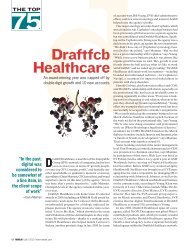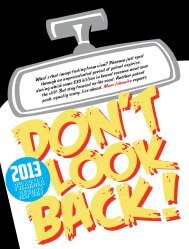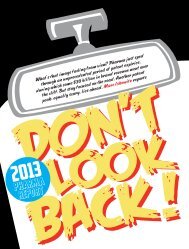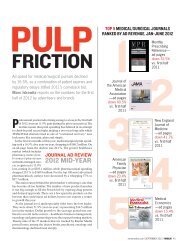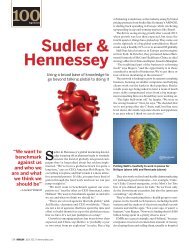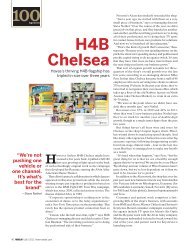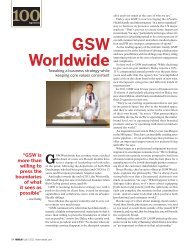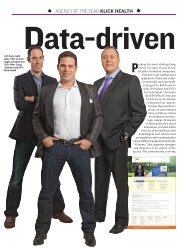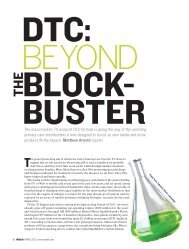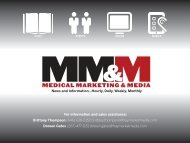(center), Steve Davis - Medical Marketing and Media
(center), Steve Davis - Medical Marketing and Media
(center), Steve Davis - Medical Marketing and Media
Create successful ePaper yourself
Turn your PDF publications into a flip-book with our unique Google optimized e-Paper software.
AstraZeneca<br />
commercial<br />
br<strong>and</strong> leaders<br />
Matt Lehmann<br />
(<strong>center</strong>), <strong>Steve</strong><br />
<strong>Davis</strong> (left) <strong>and</strong><br />
Ken Graham
SHADOWING<br />
REPS<br />
Drug companies still love their reps—just a lot less of them,<br />
especially on many mature br<strong>and</strong>s where tier-two placement,<br />
not physician awareness, is the problem. That’s the take-away<br />
from undercover observations of hundreds of sales calls<br />
at primary care doctors’ offices. Matthew Arnold reports<br />
THE<br />
Several years into the much-ballyhooed pharmaceutical sales<br />
revolution, a picture of the brave new commercial model is coming<br />
into focus. It looks a lot like the old commercial model—but<br />
scaled down quite a bit <strong>and</strong> with a few important differences.<br />
“A few years ago, everyone was saying ‘The sales force is dead,<br />
<strong>and</strong> E-this, that <strong>and</strong> the other,’” says Mike Luby of consulting firm<br />
BioPharma Alliance, “but at the end of the day, doctors vote with<br />
their feet, <strong>and</strong> they’re spending time with these guys, engaging them<br />
on the resources, <strong>and</strong> clearly valuing a lot of what they bring.”<br />
That was the upshot of a secret shopper-style study in which the<br />
firm conducted in-office observation <strong>and</strong> surveys of 461 primary<br />
care physicians as well as 209 nurses <strong>and</strong> other non-MD medical<br />
professionals. The firm sent undercover former drug reps into 219<br />
primary care physicians’ offices. They observed 661 rep visits <strong>and</strong> sat<br />
in on rep lunches <strong>and</strong> breakfasts in 108 of those offices. Upon leaving,<br />
company reps were asked to answer a few questions for some<br />
market researchers.<br />
They came away with a treasure trove of data points. Among<br />
them: calls lasted an average of six minutes; 90% of them occurred<br />
st<strong>and</strong>ing up; less than half resulted in meaningful discussion. Sales<br />
aids, used in 47% of calls, <strong>and</strong> the offering of food, seen in 16% of<br />
calls, had dramatically positive effects on depth of discussion.<br />
They also showed the enormous value not only of reps but of<br />
resources like samples <strong>and</strong> co-pay cards in the marketing toolkit.<br />
“The co-pay card is very popular <strong>and</strong> to some extent neutralizes<br />
the payer impact, becoming essentially an end run on the payer,”<br />
says Luby. “We saw that reps are talking about them very frequently.<br />
They’re gold in the marketing mix because they do so much to help<br />
doctors <strong>and</strong> patients that want to be able to access the products.”<br />
And much as they might loathe them, payers haven’t really clamped<br />
down on them for fear of being seen to squelch consumer choice.<br />
BioPharma Alliance also found that, much as physicians like co-pay<br />
cards, they greatly prefer samples,<br />
6 is the average<br />
number of<br />
minutes per sales<br />
call in BioPharma<br />
Alliance’s study<br />
of rep details<br />
offered in 80% of calls.<br />
It doesn’t require a $200,000 rep<br />
to dispense samples <strong>and</strong> co-pay<br />
cards, <strong>and</strong> companies have pared<br />
down their promotion of established<br />
br<strong>and</strong>s, with many moving to a twotiered<br />
sales force or to contract sales<br />
organizations (CSOs) for more<br />
flexibility.<br />
“Once the market really underst<strong>and</strong>s the product, <strong>and</strong> in the<br />
absence of new indications, new data, etc., you really shift to more<br />
of a service mindset,” says Luby. “You st<strong>and</strong> to lower your costs<br />
<strong>and</strong> actually improve customer service without compromising your<br />
competitive advantage.”<br />
That’s meant big reductions in US sales forces—from more than<br />
100,000 to 66,000 in 2012, a year which saw continuing layoffs as<br />
AstraZeneca shed 3,700 sales <strong>and</strong> marketing jobs, Novartis downsized<br />
mmm-online.com x NOVEMBER 2012 x MM&M 39
SHADOWING THE REPS<br />
by 1,630 <strong>and</strong> Sanofi cut 1,000-2,000 from its commercial organization.<br />
ZS Associates forecasts cuts to continue for another few years<br />
as companies absorb the impact of another $50 billion-worth of<br />
medicines set to go over the patent cliff, with rep numbers projected<br />
to bottom out at 55,000 in 2015.<br />
“Everywhere in the country, there was a red, blue <strong>and</strong> green rep,”<br />
says ZS Associates’ Chris Wright, managing director. “The red rep<br />
did two products, the blue rep did two, the green rep did two.” But<br />
with patent losses <strong>and</strong> increasing pressure from payers, many of those<br />
reps were left with only one product to detail, “so the companies<br />
have changed their models to let them take these two half jobs <strong>and</strong><br />
combine them to make a purple rep,” says Wright. “It sounds simple<br />
<strong>and</strong> obvious, but it was not easy for pharmas to pull off.”<br />
ZS Associates sees in the increasingly multi-channel sales model<br />
a role for the rep as quarterback, moving the physician from a faceto-face<br />
meeting to follow-up journal articles <strong>and</strong> video links—that<br />
take them to the br<strong>and</strong> site, that sends them to a call <strong>center</strong>, that<br />
issues an invite for a company-sponsored conference, <strong>and</strong> so on.<br />
BioPharma Alliance data shows that physicians who see reps<br />
value expertise on newer products, but what they want out of reps<br />
on established products is resources—samples, co-pay cards <strong>and</strong><br />
patient support materials.<br />
Where companies once promoted a br<strong>and</strong> heavily from launch to<br />
patent expiration, now there’s often a sharp drawdown in spending as<br />
90%<br />
is the<br />
amount<br />
of product details<br />
that occurred<br />
st<strong>and</strong>ing up in<br />
the BioPharma<br />
Alliance study<br />
“Doctors vote with their<br />
feet, <strong>and</strong> they’re spending<br />
time with these guys”<br />
— Mike Luby, BioPharma Alliance<br />
products mature. Bristol-Myers<br />
Squibb proved the test case for<br />
this approach in 2005 when, with<br />
Pravachol approaching patent<br />
expiry, the company halved sales<br />
calls on the lipid drug, a BMS<br />
cash cow. Sales held steady, <strong>and</strong><br />
BMS’s competitors followed suit<br />
as their own drugs neared loss of<br />
exclusivity.<br />
“But nobody’s really going<br />
down to zero,” says Luby. “For blockbusters, they might reduce the<br />
level somewhat, but they’re still putting a fair amount of investment<br />
into the sales force right up to the end.”<br />
A tale of three drugs<br />
Few companies have gone as far in rethinking the commercial model<br />
as AstraZeneca, which four years back created its Cornerstone division<br />
to house such mature br<strong>and</strong>s as Nexium, for which the company<br />
slashed sales support without seeing any slippage in market share.<br />
Today, the reflux drug, which became the No. 1 br<strong>and</strong> by US<br />
sales this year, after Lipitor <strong>and</strong> Plavix went over the patent cliff,<br />
is supported by a hybrid model combining service reps <strong>and</strong> a call<br />
<strong>center</strong> targeting primary care doctors with contract reps calling on<br />
gastroenterologists.<br />
“At the end of the day, I don’t think there’s really a replacement<br />
40 MM&M x NOVEMBER 2012 x mmm-online.com<br />
for face-to-face impact,” says Ken Graham, commercial business<br />
leader for Nexium. “I just think the market <strong>and</strong> where we are with<br />
the br<strong>and</strong> allow us to do some different things with it.”<br />
Nexium is just the sort of br<strong>and</strong> that doesn’t need to drive awareness.<br />
The Purple Pill has universal awareness, a well-regarded clinical<br />
profile <strong>and</strong> favorable second-tier formulary status almost everywhere.<br />
But the br<strong>and</strong> team still needs to stay close to the category’s specialists<br />
<strong>and</strong> provide them with info on new indications while dropping<br />
samples with primary care docs <strong>and</strong> educating them about access.<br />
“We have a small CSO sales force that calls on the majority of the<br />
gastroenterologists in the US,” says Graham. “They’re the thought<br />
leaders <strong>and</strong> they want to know what’s going on with the br<strong>and</strong><br />
clinically. And then we have a service channel where we have folks<br />
out there talking not clinically, but about access <strong>and</strong> affordability<br />
<strong>and</strong> providing samples to a good contingent of the primary care<br />
physicians. They’re there to reinforce access so that the healthcare<br />
professional is confident that when they write the script <strong>and</strong> h<strong>and</strong> it<br />
to the patient, they will show up to the pharmacy <strong>and</strong> get it.”<br />
That post-script nexus of pharmacy <strong>and</strong> formulary is where the<br />
battle has shifted for many br<strong>and</strong>s.<br />
“What happens is the patient shows up at the pharmacy counter<br />
<strong>and</strong> that’s when everybody finds out that this patient actually has<br />
to pay $50, not $20,” says ZS Associates’ Wright. “Some patients<br />
put up with it, but increasingly, they say, ‘Call my doctor, I want<br />
“As organized customers<br />
surface, it’s a very different<br />
kind of sales process”<br />
— Chris Wright, ZS Associates<br />
something else.’ So the pharmacist calls the doctor. The doctor hates<br />
that. The doctor is very busy. This is a big disruption. The doctor has<br />
no idea how much it really costs, but they do know that when they<br />
write prescriptions for this, they get a high percentage of patients<br />
complaining <strong>and</strong> so they start to avoid the medicine.”<br />
Even second-tier drugs like Nexium often carry co-pays ranging<br />
from $45-$60, <strong>and</strong> these drugs are competing with generic alternatives<br />
priced at a tenth of that. And Nexium, which loses US patent<br />
protection in 2014, is well-situated, given its deep br<strong>and</strong> equity.<br />
AstraZeneca has taken quite a different approach with Arimidex,<br />
which was, as commercial business leader <strong>Steve</strong> <strong>Davis</strong> says, “the<br />
analog for the loss of exclusivity,” a blockbuster that, faced with 10<br />
generic competitors, saw revenues dwindle to under $50 million in<br />
the blink of an eye after going off-patent three years ago.<br />
“The thing about Arimidex was, I checked the information <strong>center</strong>,<br />
<strong>and</strong> we were getting calls all the time from consumers about how<br />
they could get br<strong>and</strong>ed Arimidex, <strong>and</strong> once we started digging into it,<br />
we realized that the cash price for patients for the generic was really<br />
quite high. That got the wheels spinning. Breast cancer is such an<br />
emotional issue, <strong>and</strong> we thought we could do something different.”<br />
And so the br<strong>and</strong> team put the bulk of its budget into creating a<br />
strong direct-to-patient effort, the fruit of which is Arimidex Direct,<br />
which has enrolled over 2,000 patients to date. The program has been<br />
promoted through the website <strong>and</strong> through word of mouth via patient<br />
advocacy groups <strong>and</strong> breast cancer blogs. In October, the company<br />
created a social media badge for the site to make sharing easy <strong>and</strong>
US sales forces continue to shrink<br />
This year’s sales/marketing layoffs by Novartis (1,630), AstraZeneca<br />
(3,700) <strong>and</strong> Sanofi (about 1-2,000) contributed to another decrease<br />
in US sales force size<br />
US Sales reps (000’s)<br />
100<br />
80<br />
60<br />
40<br />
20<br />
0<br />
98<br />
95<br />
Source: ZS Associates analysis<br />
83<br />
2007 2008 2009 2010 2011 2012 (Q3)<br />
posted a video on how easy it is to register for the program, which<br />
has shown a marked jump in adherence for enrollees.<br />
“The science says Arimidex helps breast cancer survivors if they<br />
stay on Arimidex for five years,” says <strong>Davis</strong>. “The average person<br />
stays on six months.”<br />
<strong>Davis</strong>, who h<strong>and</strong>les AstraZeneca’s Foundation Br<strong>and</strong>s portfolio<br />
of 18-plus mature drugs, says these br<strong>and</strong>s “have already established<br />
br<strong>and</strong> equity <strong>and</strong> doctors have usage patterns for those br<strong>and</strong>s <strong>and</strong><br />
know how they would be using them, so a lot of my effort is really<br />
tapping into that br<strong>and</strong> equity <strong>and</strong> doing it in cost-effective <strong>and</strong><br />
efficient ways.” His team does very little on the professional side, <strong>and</strong><br />
most of that is directed at non-physician healthcare professionals.<br />
“Consumers should have a choice,” says <strong>Davis</strong>. “Do you buy a<br />
store br<strong>and</strong>, or the real thing? When a br<strong>and</strong> goes mature, they’re<br />
never going to be the size that they were, but we can compete <strong>and</strong><br />
continue to drive revenue that helps fuel further R&D.”<br />
For antipsychotic Seroquel XR, given the complexity <strong>and</strong> fastchanging<br />
nature of neuroscience, foregoing sales support wasn’t an<br />
option. “We rely first on a highly-trained professional sales force,”<br />
says Matt Lehman, commercial business leader for the br<strong>and</strong>. “But<br />
it used to be that the commercial formula was one of reach <strong>and</strong><br />
frequency at pretty much any cost, <strong>and</strong> the game has completely<br />
changed. Now we’re reaching a very focused group of physicians<br />
<strong>and</strong> trying to do that at a frequency that makes sense for them, <strong>and</strong><br />
for us <strong>and</strong> our business.”<br />
For Seroquel XR, AstraZeneca supplements a robust direct sales<br />
program calling on psychiatrists with phone <strong>and</strong> digital outreach,<br />
along with a direct-to-patient program. It’s a far cry from the onesize-fits-all<br />
approach of the pre-patent cliff era.<br />
“We’re listening to the market dynamics better than we have in<br />
the past,” says Lehman. “Not every br<strong>and</strong> is in the same scenario,<br />
so we h<strong>and</strong>le them all differently.”<br />
78<br />
66<br />
64<br />
“If you have an individual<br />
sales goal, that’s what<br />
drives a lot of the behavior”<br />
— Eric Dube, GlaxoSmithKline<br />
ueroSto commodo odionul<br />
Glaxo’s gambit<br />
Another company that got out front of reworking the commercial<br />
model was GlaxoSmithKline, which in 2010 dispensed with an incentives<br />
structure that rewarded individual achievements <strong>and</strong> replaced<br />
it with one based more on qualitative measures.<br />
“The shift from volume to value is a major driver not just for pharma<br />
but really all of the stakeholders in the US healthcare market,”<br />
says GSK’s Eric Dube, SVP for strategic planning <strong>and</strong> operations.<br />
“We see it in the accelerated pace of consolidation <strong>and</strong> integration<br />
of our healthcare delivery systems, <strong>and</strong> with that, there’s been a big<br />
shift in sophistication of our customers.”<br />
Those changes, sped by the<br />
Affordable Care Act, are sure to<br />
continue, whatever the balance<br />
of power in Washington. The shift<br />
from quantitative to qualitative<br />
reimbursement has taken root<br />
in healthcare.<br />
GSK has eschewed the service<br />
rep model, instead trying<br />
to increase responsiveness to<br />
80% is the<br />
amount<br />
of sales calls in the<br />
study during which<br />
product samples<br />
were offered<br />
customers. The company’s incentive program is called Patients First.<br />
Two years out, feedback from physicians suggests it’s working, says<br />
<strong>Steve</strong> Sullivan, head of corporate <strong>and</strong> independent accounts.<br />
“We’ve had customers comment that we show up <strong>and</strong> engage them<br />
differently,” says Sullivan. “In fact, it’s enabled us to gain access to<br />
customers that had been shut off <strong>and</strong> we’ve renewed our relationship<br />
with them through having a different type of dialogue with them.”<br />
Fostering collaboration, rather than competition, among the sales<br />
team is making the difference, says Dube. “I think we underestimated<br />
how the traditional incentive model was an impediment to strong<br />
collaboration around the customer in the field,” he says. “If you have<br />
an individual sales goal, that’s what drives a lot of the behavior.”<br />
“You might have had two territories in a large metropolitan area,<br />
with two different reps in the same therapeutic area selling the same<br />
products but with individual goals, [so] any success they were having,<br />
they would keep to themselves,” says Sullivan, “because they’d be<br />
ranked directly against the person in the territory next door. There<br />
was no incentive for them to share the insights garnered broadly.”<br />
Now, says Dube, reps are psyched to share information <strong>and</strong> best<br />
practices for the benefit of the customer rather than focusing solely<br />
on driving the next prescription.<br />
GSK has downsized its sales forces sharply over the past five years<br />
while making investments in technology <strong>and</strong> analytics <strong>and</strong> building<br />
an account management organization calling on the leaders of large<br />
provider organizations, health systems <strong>and</strong> associations.<br />
“There, we’re spending more <strong>and</strong> more time with the folks who<br />
lead these organizations, <strong>and</strong> who are charged with delivering better<br />
value <strong>and</strong> better patient care within them,” says Sullivan. “Through<br />
these discussions, we’ve really heightened our underst<strong>and</strong>ing of the<br />
business, <strong>and</strong> we’re sharing that broadly across our team, so that<br />
when our reps show up <strong>and</strong> talk to a clinician who cares directly<br />
for patients, they’re much better informed on the objectives of the<br />
broader business.”<br />
On some occasions, says Dube, healthcare company execs have<br />
asked these key account reps to share information with care coordinators<br />
for offices that don’t see reps. “We say we don’t have access<br />
to those offices, <strong>and</strong> they say ‘Well, tell them I sent you.’”<br />
mmm-online.com x NOVEMBER 2012 x MM&M 41
SHADOWING THE REPS<br />
“As these organized customers surface, it’s a very different kind of<br />
sales process,” says ZS Associates’ Wright. As physicians’ practices are<br />
swallowed up by bigger <strong>and</strong> bigger group practices, “some of those<br />
groups say, ‘We don’t want you visiting with the doctors directly,’ so<br />
they’ve agreed to a protocol.” Increasingly, Wright notes, hospitals<br />
reimburse doctors according to an outcomes-based incentive program,<br />
too. Formularies often figure into those incentive schemes,<br />
<strong>and</strong> the challenge of securing favorable placement falls to the key<br />
account rep.<br />
“Our sales reps are product experts <strong>and</strong> therapeutic experts,” says<br />
Sullivan. “Our account management organization, they’re really<br />
customer experts, charged with underst<strong>and</strong>ing the customer, their<br />
business, their practice, their patients, <strong>and</strong> what their goals are to<br />
deliver care. We share that information across our organization to<br />
align the best resources we have <strong>and</strong> deliver value to the customer<br />
in a way that’s aligned with their goals <strong>and</strong> objectives.”<br />
No-See No Choice<br />
There’s been much h<strong>and</strong>wringing over the growing number of<br />
“No-see” doctors who will not see reps, which now constitutes as<br />
much as a fifth of all physicians.<br />
54%<br />
is the<br />
amount<br />
of “No-see no<br />
choice” docs who<br />
expressed interest<br />
in seeing reps if<br />
their practice<br />
would allow it<br />
42 MM&M x NOVEMBER 2012 x mmm-online.com<br />
BioPharma Alliance said more<br />
than three quarters of such docs<br />
are “No-see” not by choice but<br />
because the hospital or group<br />
practice they belong to has a<br />
policy prohibiting interactions<br />
with drug company reps. Most of<br />
them would like to see reps <strong>and</strong><br />
feel that they <strong>and</strong> their patients<br />
are missing out as a result.<br />
Assuming that 20% of primary<br />
care physicians fall into the no-<br />
see category, Luby estimates that only around 4% of physicians<br />
are “No-see by choice.”<br />
But the group that’s really growing is that other 16%, as more <strong>and</strong><br />
more institutions are closing their doors. And we asked them: Does<br />
your practice miss out on resources of value by not seeing reps?<br />
And in that group, 70% say they miss out.” Those docs said, by the<br />
same ratio, that their patients miss out, too. When asked what they’re<br />
missing, they said not tchotchkes, but info on new drugs, samples, copay<br />
cards <strong>and</strong> patient support resources. Lunches were mentioned,<br />
said Luby, but didn’t st<strong>and</strong> out. More than half of these “No-see no<br />
choice” docs expressed interest in seeing reps if their practice’s policy<br />
against it were reversed (54%).<br />
There’s also evidence that these no-see doctors are slower to<br />
respond to emerging clinical information. A study by ZS Associates<br />
<strong>and</strong> AstraZeneca looked at prescribing habits following three events:<br />
the October 2006 launch of Januvia; the August 2007 black box warning<br />
on Av<strong>and</strong>ia; <strong>and</strong> the January 2008 release of discouraging clinical<br />
trials data for Vytorin. No-see docs who maintained “very low” rep<br />
access to their offices were up to 4.6 times slower to introduce Januvia<br />
to patients than were those who imposed a “medium” level of access,<br />
as determined by the authors. The “very low” access docs took four<br />
times longer to reduce their use of Av<strong>and</strong>ia than their “medium”<br />
access colleagues, <strong>and</strong> showed “significantly less” response to the<br />
Vytorin data than did their less restrictive colleagues.<br />
“Policies that promote physician ignorance of new medical infor-<br />
The “can’t-see” doctor<br />
Among the 20% of primary care physicians who do not see reps,<br />
about three-fourths do not see reps because that’s the policy of their<br />
group, practice or institution<br />
Source: BioPharma Alliance<br />
80%<br />
See reps<br />
mation resulting from access limits runs counter to protecting patient<br />
health,” said the study’s lead author George Chressanthis, a former<br />
AstraZeneca exec who is now acting director of the Center for<br />
Healthcare Research <strong>and</strong> Management at Temple University’s Fox<br />
School of Business.<br />
BioPharma Alliance’s study found that reps are easily the No. 1<br />
source of info on new products for those docs that see them, with<br />
nine out of 10 reporting being detailed on new treatments three or<br />
more times per month. Those that don’t see reps cited journals as<br />
their top info source, with 64%-68% reading about new products<br />
in journals three or more times per month, followed by colleagues<br />
(52%-53%), websites like Epocrates, Medscape <strong>and</strong> UptoDate (46%-<br />
52%), apps (27%-32%) <strong>and</strong> package inserts (25%-29%). Similar<br />
numbers were seen for learning about established products.<br />
Luby says the firm employed the “more or less than three times a<br />
month” benchmark to distinguish doctors who occasionally dabble<br />
in a medium from those who regularly engage it. E-detailing <strong>and</strong><br />
other forms of non-personal promotion, once expected to transform<br />
the commercial model for established products, haven’t moved the<br />
needle on that mark. Just 4%-7% of docs surveyed reported participating<br />
in online or e-detailing three or more times per month.<br />
Most never do e-details—that’s<br />
31% is the<br />
amount<br />
of sales calls<br />
in which co-pay<br />
programs were<br />
offered<br />
16%<br />
No-see<br />
no choice<br />
what 75% of no-see no choice<br />
docs, 74% of no-see by choice<br />
docs <strong>and</strong> 60% of docs who do<br />
see reps said.<br />
“A lot of non-personal promotion<br />
has ended up being impersonal<br />
promotion,” says Luby.<br />
“You still have a lot of these<br />
experiences that aren’t custom-<br />
ized to an individual doctor, <strong>and</strong> so the doctor is getting this generic<br />
detail, whereas a rep can, within legal bounds, tailor a discussion to<br />
<strong>and</strong> have a back-<strong>and</strong>-forth with the doctor. The rep is really an ondem<strong>and</strong><br />
resource, whereas e-detailing is hard to personalize.”<br />
There’s also the convenience factor.<br />
“All the doctor has to do with a rep is break stride in the hallway,”<br />
says Luby. “It doesn’t really cost them anything, it’s just a couple<br />
minutes between patients that they can make up elsewhere in their<br />
day. They don’t have to go to a website or tap an app or anything,<br />
4%<br />
No-see<br />
by choice
No-See By Choice: the hardcore 4%<br />
Around 15%-20% of primary care physicians don’t see sales reps.<br />
BioPharma Alliance puts the figure at 20%, <strong>and</strong> of that, less than a quarter—4%<br />
of the total population of physicians—are so-called “No-See By<br />
Choice” docs for whom not seeing reps is a matter of conscience rather<br />
than practice or hospital policy. While “No-See No Choice” docs’ ranks<br />
are growing fast as institutions bar their doors to drug companies, that<br />
4% has remained static.<br />
“They just don’t want to see reps,” says BioPharma Alliance’s Mike<br />
Luby. “It’s a very cynical crowd. ‘Lower your darn drug prices’ pretty<br />
much sums up what they have to say.’”<br />
Unlike those that don’t see reps because they’re barred from doing so,<br />
who report having a harder time than most docs keeping current with<br />
drugs <strong>and</strong> biologics, No-See By Choicers find it easier to keep up than<br />
their colleagues who do see reps or who might like to. They consult<br />
journals <strong>and</strong> websites at a higher rate <strong>and</strong> rely on their colleagues more<br />
for medical information. Their go-tos for new products are Epocrates,<br />
UptoDate, Medscape, meetings <strong>and</strong> conferences <strong>and</strong> the New Engl<strong>and</strong><br />
Journal of Medicine. For established products, they prefer—again—<br />
Epocrates, UptoDate <strong>and</strong> NEJM, along with PDR <strong>and</strong> colleagues.<br />
A little over half of No-See By Choice docs accept samples (55%),<br />
according to BioPharma Alliance, which surveyed 85 such docs. That’s<br />
a shade more than No-See No Choice docs (52%). Just a quarter of all<br />
docs that don’t see reps say they use co-pay programs, <strong>and</strong> they report<br />
low satisfaction with them—but not that much lower than docs that do<br />
see reps (28% of No-See By Choice docs said they get “a great deal<br />
of satisfaction” when a patient is able to use a co-pay program they’ve<br />
referred them to). Their preference for samples over co-pay programs<br />
tracks about evenly with other docs—which is to say that it’s no contest<br />
(79% prefer samples).<br />
One No-See By Choice doc is David Evans, MD, whose rural Oregon<br />
family practice banned reps in 2006. In a<br />
qualitative case study published in the Journal of<br />
Family Practice, he <strong>and</strong> his colleagues reported<br />
that their clinic functioned more efficiently without<br />
reps underfoot, that they <strong>and</strong> their patients<br />
felt better about the integrity of their practice,<br />
that they didn’t miss samples <strong>and</strong> questionable<br />
information from industry. They even preferred<br />
their clinic-funded lunches to those the reps<br />
David Evans, MD<br />
brought in.<br />
“For years, we were heavily detailed,” says Dr. Evans, who is now at<br />
the University of Washington, Seattle. “We were seeing something on<br />
the order of 30 visits a month, <strong>and</strong> it was really interfering with patient<br />
flow, <strong>and</strong> so this was a practical as well as an ethical decision. When<br />
it’s one rep, that’s one thing, but three a day is a lot of time—that’s a<br />
couple patient visits.”<br />
Dr. Evans <strong>and</strong> his colleagues worried about bias in scientific info that<br />
came from companies.<br />
“It became increasingly difficult to distinguish valuable info from<br />
propag<strong>and</strong>a,” says Dr. Evans, who at one point asked reps to bring in<br />
only peer-reviewed materials. “But we eventually decided it just wasn’t<br />
worth it <strong>and</strong> now information access is a lot easier. There are other<br />
ways to get information now.” Dr. Evans likes The <strong>Medical</strong> Letter <strong>and</strong><br />
The Prescriber’s Letter.<br />
“I find sampling to be particularly bothersome, actually. Maybe a<br />
couple of our patients benefited, but for the most part I don’t think they<br />
missed out. Data I’ve seen shows that samples don’t wind up in the<br />
h<strong>and</strong>s of the indigent.”<br />
Patient feedback was overwhelmingly positive. “They get the conflict<br />
of interest issue a whole lot better than doctors do,” said Dr. Evans.<br />
ueroSto commodo odionul<br />
because as simple as that sounds, it requires walking to your desk,<br />
finding the e-detail <strong>and</strong> the product you want to do, clicking on it<br />
<strong>and</strong> engaging in it. It’s hard to fit in during the frenzy of the day<br />
<strong>and</strong> it competes with too many other things for their time outside<br />
of the office.”<br />
ZS Associates’ Wright says some companies are getting around<br />
the impersonal-ness <strong>and</strong> inconvenience of e-details <strong>and</strong> other digital<br />
offerings by having a live rep introduce them.<br />
“They used to go around the rep, but now they’re engaging them in<br />
it, <strong>and</strong> they see a very different outcome when the rep says, ‘Hey, doc,<br />
listen, I know you’re busy <strong>and</strong> can’t make it to that dinner meeting,<br />
but Mr. Fancy Doctor Who We All Respect is going to speak, <strong>and</strong> I<br />
can provide you with a podcast of it.’ Well, the podcast saves them<br />
time, but their willingness to view it is because it was recommended<br />
by someone they know.’”<br />
Wright is bullish on e-promotions, including video detailing,<br />
webinars, eCME, email marketing,<br />
physician communities <strong>and</strong><br />
social media. While these media<br />
make up only 3% of all marketing<br />
spend (around a half-billion<br />
dollars), his firm predicts that<br />
pharma use of them will triple<br />
by 2014, but cautions that “getting<br />
it right will require Amazonlike<br />
predictive techniques.” ZS<br />
found that a mash-up of predic-<br />
8%<br />
is the<br />
amount of<br />
samples sent via<br />
mail. AstraZeneca,<br />
Publicis <strong>and</strong><br />
Sanofi send them<br />
the most<br />
tive models combining a doctor’s history with that of “like” doctors<br />
can enhance email open rate predictions.<br />
With doctors increasingly pressed for time <strong>and</strong> NPs <strong>and</strong> other<br />
office staff playing a greater role in dispensing samples <strong>and</strong> copay<br />
cards, companies are directing more of their attention toward<br />
non-physicians. In BioPharma Alliance’s study, non-MD contact<br />
occurred in 43% of calls, lasting an average of six minutes. Two-way<br />
conversation was observed in 70% of those calls, with just-small-talk<br />
accounting for 47%. Sales aids were used in 19%, <strong>and</strong> the healthcare<br />
professional asked a question in 5%.<br />
For Arimidex, calling on nurses <strong>and</strong> other non-MD office staff<br />
has been a big part of the br<strong>and</strong>’s spare professional efforts. “A lot<br />
of doctors tell us, ‘Please make sure my staff knows this, okay?’”<br />
says AstraZeneca’s <strong>Davis</strong>. “In oncology offices, they have a lot of<br />
advocacy programs, <strong>and</strong> nurses help out the patients.”<br />
“Certainly, with the increased number of patients that are going<br />
to flow into the system, we’re hearing more about team-delivered<br />
healthcare, about allied healthcare professionals working at the top<br />
of their licensure to free up physicians,” says GSK’s Sullivan.<br />
“The focus is really shifting to the office staff,” says Luby. “They’re<br />
the ones h<strong>and</strong>ing out the co-pay cards, the samples. They can be<br />
influential in the choice of the script.” Their role is sure to grow as<br />
the “Silver Tsunami” of Boomers hits doctors’ offices.<br />
“Doctors still hold the power, because you need them to believe in<br />
the product <strong>and</strong> write the script—that’s the reality that was heavily<br />
weighted back in the late ‘90s <strong>and</strong> early 2000s,” says AstraZeneca’s<br />
Graham. “We’ve just had other market forces playing in since then,<br />
<strong>and</strong> now there’s a gauntlet the patient has to run through after getting<br />
the script. The patients are much more informed, <strong>and</strong> they are<br />
more involved, especially when there’s cost pressures on them. So<br />
it’s no longer a one-size-fits-all model.” n<br />
mmm-online.com x NOVEMBER 2012 x MM&M 43



